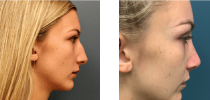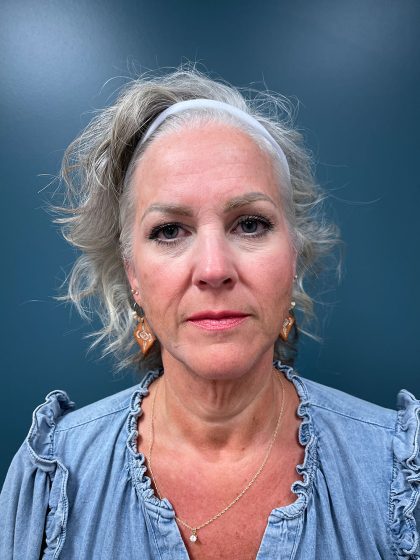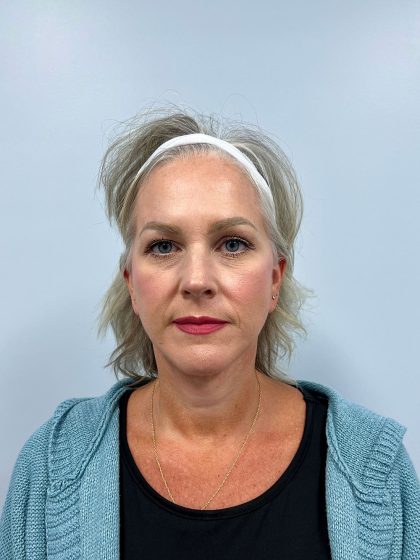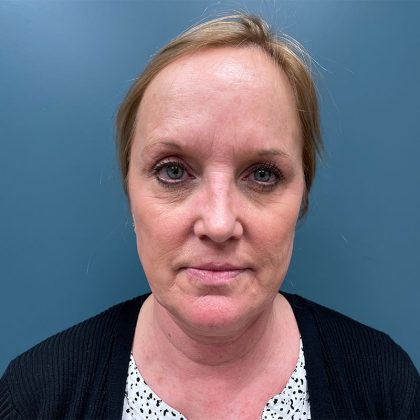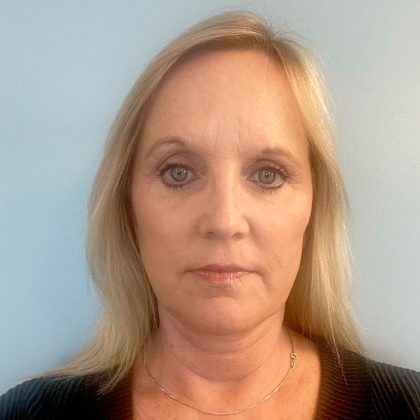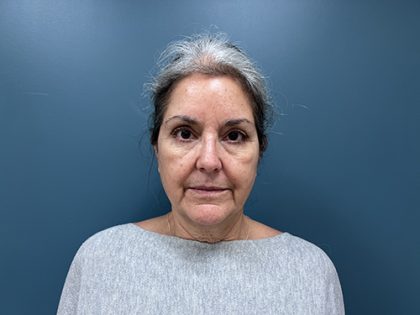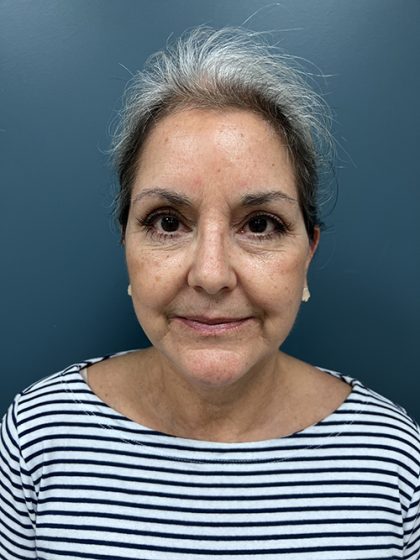A full facelift, or traditional rhytidectomy, is a procedure that tightens and rejuvenates the lower and mid sections of the face. It only requires subtle incisions around the ears, hairline, and below the chin to correct sagging jowls and droopiness around the cheeks and neck. Sometimes, it takes a little lift to contour your natural features in the most flattering way possible and take years off of your face. In other cases, a full facelift is necessary for the rejuvenated appearance that is desired.
At Plastic Surgeons of Lexington, we understand that looking your best means you get to present your best self to the world. Our staff of medical professionals led by three board certified plastic surgeons will provide you with the well-rounded medical knowledge and care you need to make your aesthetic vision come to life. Give us a call at (859) 276-3883 to learn more or fill out our online form for any and all questions you may have.
Contents
Before and After Photos
Evolution of the Facelift
The origin of the facelift traces back to more than 100 years. The procedure was first mentioned in the 1912 book “Cosmetic Surgery” by surgeon Eugene von Hollander, who claimed to have performed his first facelift in 1901 on a Polish aristocrat. Charles Miller became the first American doctor to publish an article on the facelift in 1907.
In 1976, Dr. Vladimir Mitz and Dr. Martine Peyronie discovered the superficial musculoaponeurotic system (SMAS), a layer of facial muscle and connective tissue distinct from other fatty layers and skin. Their research on how to manipulate this tissue paved the way for how facelift procedures are conducted today. (1) Modern facelift surgeries address this vital layer of tissue, and/or the tissues beneath it in order to lift and rejuvenate the face. Unlike other more superficial procedures, this is a long-lasting and effective way to reposition the tissue and turn back the clock. In addition to addressing the jawline, a facelift is often combined with a neck lift for a complete transformation. If the signs of aging that are troubling you go beyond a few wrinkles or mild drooping or volume loss, it might be time to explore all the benefits of a facelift!
Preparation
To prepare for a facelift, we will first require a few blood tests to rule out any major health problems. You should stop taking any medication or supplement that thins the blood since this can cause unwanted bleeding. You should avoid drinking alcohol (also a blood thinner) for at least 2 weeks before your surgery date. If you are a smoker, you will need to stop smoking 4 to 6 weeks before surgery; nicotine can impede your blood flow and the healing process.
Proper skincare beforehand is also a big factor in how your results will turn out. We advise avoiding the sun or using sunblock of SPF 30 or higher for at least 2 weeks prior. Sun damage to your skin cells can negatively affect how your incisions will heal. In the days leading up to your procedure, try to keep your skin well-hydrated and healthy.
The day before your procedure, you may wash your hair, but avoid using styling gels, creams sprays, or dyes. On the day of your procedure, do not wear any makeup or topical facial creams.
Finally, you should arrange for someone to take you home after your procedure. Whether you opt for general anesthesia or local anesthesia with sedation, you will not be able to drive home yourself. On the day of your surgery, you should consider wearing a buttoned or zip-up top to avoid having to pull it over your head when changing clothes.
Procedure
After administering anesthesia, one of our surgeons will mark where the incisions will be made. A facelift requires incisions around the ear and into the hairline, but scars can be easily hidden. Any scars that result fade significantly with time and proper aftercare treatments.
Whether you undergo a SMAS lift or a deep plane facelift, both methods have been proven to provide safe and satisfactory results. (2)
SMAS Lift
In this method, the skin is separated from the SMAS, which is then modified to lift the underlying tissues of the face. Incisions and or carefully placed sutures reposition this layer so that the skin can be redraped and a smoother, more youthful appearance can be achieved. Any excess skin is removed before the incisions are closed with sutures. Through the incisions around the ear or beneath the chin, the surgeon can also tighten the platysma muscle, the muscle surrounding the neck and extending over the jaw, and remove excess fat in order to rejuvenate the neck.
Deep Plane Facelift
In a deep plane facelift, the surgeon moves the skin remains attached to the SMAS, and the surgeon addresses the deeper underlying tissues. This places less tension on the skin, and can lead to a shorter recovery, as there is less disruption to fewer layers of tissue. The surgeon may also make modifications to ligaments to smoothen out and lift facial folds. A deep plane facelift is often performed if the patient has thick skin with adequate facial fat.
The entire procedure usually takes 2 to 3 and a half hours.
Recovery
You must keep your surgical dressings and compression bandage on until your follow-up appointment the next day. While you will be tender after the anesthesia entirely wears off, one of our doctors will prescribe medication to help you handle the discomfort. They can also recommend over-the-counter medications that are just as suitable to use while you heal. Swelling, bruising, numbness and redness are all completely normal for the first few days. You’ll be given a chin and head strap to wear to support your healing tissues.
The recovery period for a facelift is two weeks. After one week, your sutures will be removed; some may choose to go back to work. By the time two weeks are up, you will be able to use skincare products and go back to work.
Benefits of a Full Facelift
A facelift can provide a natural-looking transformation. The procedure can correct the sagging and folds that are causing droopiness around the mouth, so you’ll appear more perky and vibrant. Your smile will shine through much better after correcting this area. The procedure can also help accentuate your jawline and tighten the neck to recreate a more graceful side profile. Makeup will also be much easier to apply with smooth, taut skin. Compliments on how good you look for your age will skyrocket alongside your self-confidence!
Candidates
To ensure you get the best results possible, one of our surgeons will carefully examine your eligibility for a full facelift. The ideal candidate:
- Is a person in their 40s, 50s, or 60s.
- Has mild to moderate signs of skin deflation and descent.
- Has an adequate amount of fatty tissue in the face.
- Has mild to moderate skin laxity, or looseness.(3)
As with any procedure, patients should also be in overall good health, non-smoker, and have no underlying conditions that impede healing or circulation.
Results
A facelift can completely change the way you see yourself. With this procedure, you can feel like your most attractive, confident self. This procedure allows you to age beautifully without aging skin weighing down your appearance. It results in:
- A more defined chin and jawline.
- Perkier cheeks.
- Less-defined nasolabial folds (also called smile lines).
- Less defined marionette lines, lip lines, and other wrinkles around the mouth.
- Reduction of neck skin laxity
Personal Consultation
A personal consultation is an opportune time for our staff to address your concerns about the procedure, expectations, and recovery. Our board certified surgeons are well-versed in understanding patients’ needs beyond the operating room. Here is what you need to know to have a successful consultation:
- Communicate clearly your expectations and what alterations you would like to see from your procedure. The doctor can then determine if a full facelift is the right choice for you.
- Ask our surgeons, Dr. Joseph L. Hill Jr., Dr. Michael P. Lynch, and Dr. Evan Moore their opinions to get a well-rounded idea of what will work best for your aesthetic desires.
Corresponding & Complementary Procedures
We understand that a facelift may not be for everybody, so we offer several anti-aging options to fit every patient’s unique needs:
- Mini-facelift– Addresses only the jawline and lower cheeks.
- Mid-facelift– Addresses only the upper cheeks (not jawline) and creases around the eyes.
- Facial fat grafting– Fat can be transferred from other areas of the body to restore lost volume in the face.
- Botox– An injection that prevents wrinkles by relaxing the facial muscles.
- Restylane– This dermal filler utilizes hyaluronic acid, a substance that is produced naturally in the body, to reduce the appearance of lines and wrinkles.
- Juvederm: This dermal filler also uses hyaluronic acid, to restore lost volume in the face and reduce wrinkles.
Regardless of the procedure, we prioritize safety and natural results that you will love. Check out our blog to educate yourself more on the life-changing procedures we offer.
Cost of a Facelift in Lexington, Kentucky
The cost of your facelift will depend on the technique used, and how much surgical intervention will be required to achieve your aesthetic goals. Our staff at Plastic Surgeons of Lexington spend quality time with each patient to discuss their vision, concerns, and everything in between. Book a consultation today or call us to get an idea of what your facelift will cost.
FAQ
Can a full facelift fix sagging near the eyes?
A facelift does not treat sagging in the upper eyelids, but it may reduce the appearance of under-eye bags and crow’s feet.
How long do the results of a full facelift last?
If you consistently use sunscreen and practice good skincare, the results can about 10 years or more.
Does a full facelift treat sagging skin on the neck?
Yes, a full facelift often requires an incision below the chin so that the playsma (neck muscle) can be modified to promote a taut appearance in the neck. Other techniques are also used to contour the neck area.
What is the difference between a full facelift and a mini-facelift?
The mini-facelift only treats signs of aging around the mouth, lower cheeks, and jawline. The full facelift addresses wrinkles and folds around the mouth, cheeks, jawline, eyes, and neck.
References
- Barrett DM, Casanueva FJ, Wang TD. Evolution of the rhytidectomy. World Journal of Otorhinolaryngology – Head and Neck Surgery. 2016;2(1):38-44. doi:https://doi.org/10.1016/j.wjorl.2015.12.001
- Rammos, C.K., Mohan, A.T., Maricevich, M.A. et al. Is the SMAS Flap Facelift Safe? A Comparison of Complications Between the Sub-SMAS Approach Versus the Subcutaneous Approach With or Without SMAS Plication in Aesthetic Rhytidectomy at an Academic Institution. Aesth Plast Surg 39, 870–876 (2015). https://doi.org/10.1007/s00266-015-0558-9
- Plane Facelift/Rhytidectomy. Facial Plastic Surgery. 2020;36(04):376-385. doi:https://doi.org/10.1055/s-0040-1714118




